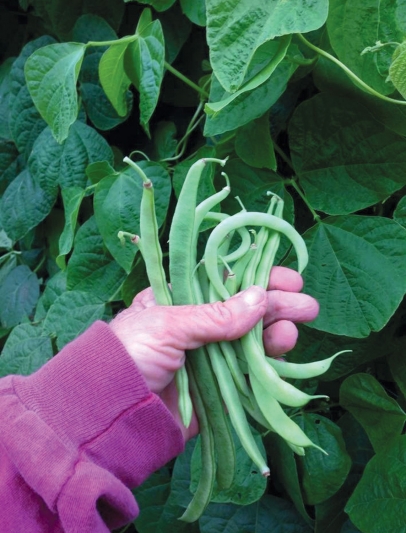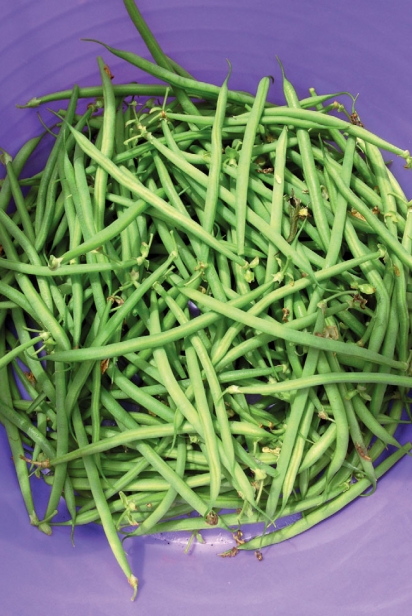Pole Bean Renaissance
Italian Renaissance gourmet Bartholomew Scappi, author of the monumental cookbook published in 1570, Opera dell’Arte del Cucinare (presenting us with the first known picture of the fork), described dishes of beans with eggs, cinnamon, walnuts, sugar, onions and butter in his cookbooks. Catherine d’ Medici of Florence was said to be so enamored with the beans that grew in her native Italy that she smuggled some to France when she married Henry, Duke of Orleans, later to become King Henry II of France.
I know how Catherine felt. There’s nothing quite like an Italian flat bean, but how did an ancient food of the Americas become the pride of Italy?
Over the last 8000 years the common bean (Phaseolus vulgaris) evolved from a wild weedy vine of the Americas into a worldwide crop with a plethora of diverse cultivars. Beans come in an enormous variety of shapes, sizes, colors, textures and tastes, yet today we are rarely privy to any but the most common. At last count it is was estimated that more than 4000 varieties exist in North America alone, but only a small fraction of them are available commercially. The rest are in private collections and seed banks.
Exactly where and when the actual domestication of the wild bean began is a mystery, but archeological discoveries have put it somewhere from northern Mexico to Argentina, particularly Mesoamerica and in the Andes, with multiple domestications of the bean throughout this area giving it at least two distinct primary gene pools.
After domestication in these regions, over many thousands of years beans were introduced into other regions of the world, along different pathways. Some moved into lowland South America and Africa, Brazil and the American Southwest, with the Andean cultivars predominating in Africa, Europe and Northeast America. The bean traveled through trade northwards and were carried by native peoples as far north as Canada. Navy and black beans sailed from the Caribbean up the east coast and then were carried to the Great Lakes region, and kidney beans were moved as part of the slave trade by Europeans to Europe and on to East Africa (a secondary center of domestication), ultimately returning to the east coast of the United States as the heirloom varieties we know today, introduced by the early settlers.
Perhaps the widest variety and some of the most delicious heirloom cultivars today are found in Europe. The green bean was brought to the Mediterranean upon the return of Columbus from his second voyage to the New World in 1493. By the 16th century, with ships sailing around the world, Europeans began to be introduced to some of the exotic foods that the New World had to offer, among them the common bean. In the beginning, the bean’s sensitivity to day length and cool temperatures in many European latitudes must have been a struggle for farmers, but finally their fondness for this new vegetable won out. Italy, Greece and Turkey, and later France, cherished the New World green beans. Beans, especially green beans, soon became a popular vegetable throughout Europe. And the dried beans became an invaluable crop because of their nutritional value and long storage times. Dry beans quickly became a primary food for sailors, which is how the Navy bean got its name. The earliest depiction of the New World bean in Europe is believed to be the woodcut from Leonhart Fuchs’ Herbal published in 1543.
Back in Mesoamerica five thousand years ago, the fabled Three Sisters garden was sharing a co-evolutionary relationship with humans. According to archeological findings, humans began cultivating and caring for these plants—corn, beans and squash—and the plants thrived under their care. Corn and beans, consumed together, form a complete protein, and had become these early civilizations’ sustenance, paving the way for humans to transition from hunter-gatherer to farmer. Not only was this pairing the perfect food, but the these plants grown together, along with the addition of squash, benefit one another immensely. Corn provides a structure on which the beans can climb. The beans in turn provide nitrogen to the soil, and the squash becomes a natural groundcover, conserving moisture. Overall, say crop scientists, more protein and energy is produced by intercropping three crops in the same space than that which is achieved by monoculture agriculture.
As the bean completed its trans-global evolutionary journey and ended back on the shores of New England, this ancient combination once again became a dietary essential of the Americas. Succotash was a staple of our forefathers as they settled in the New World, and was derived from the ancient combination of plants introduced to them by the Native Americans. Embedded in the traditions of a New England family, I know how important it was. We were brought up eating succotash quite regularly and even have special deep dish pottery succotash bowls in the cabinet today that have been passed down for generations with care. The curious name succotash comes from a Narragansett Indian word meaning broken corn, referring to the way it was originally stripped off the corncob and the cob pressed to release the pulpy, milk-like starch into a bowl. And although it is usually served during the winter months, using dark red kidney beans, lima or cranberry beans, and drenched in cream and butter as a hardy meal, there’s a new twist on the traditional recipe combining Old World cookery with modern preferences for a lighter, more modern meal. For this recipe you use fresh corn, cut off the cob, thinly sliced Italian Romano beans with plenty of butter, and a little water to turn the starchy corn into a thin sauce. You can also stir in a bit of parsley or some herbs.
As its name suggests, the Romano pole bean was bred in Italy. Pole beans yield a much longer harvest per season than bush bean varieties. Their season stretches into the late fall, during shorter days and cooler nights. The smaller bush beans produce a lot of beans in a short amount of time, so they need to be planted several times for a long season of harvest. Most home gardeners do not realize that bush beans are really a single harvest bean and wonder why they suddenly stop producing well before summer’s end.
I like to start the season off with a few heirloom bush varieties, planting pole varieties at the same time. This way I still get an early harvest while waiting for my pole varieties to mature. Although pole beans take much longer to produce, they are well worth the wait. Remember to provide a very strong and tall trellis, as they can grow anywhere from 6 to 15 feet tall.
Like grocery store tomatoes, bean cultivars produced commercially (all commercial beans are bush types) are not necessarily chosen for flavor but rather attributes varying in importance such as yield, ease of harvest, disease resistance, uniformity and so on, unlike pole varieties whose seeds are saved more often to preserve their epicurean delights.
Both the modern flat beans and the more slender string bean varieties, if picked while young, are stringless. Older varieties, or beans allowed to ripen on the vine, may contain strings. Look for the improved varieties of the old heirloom seed, as this usually means they are stringless and more disease resistant.
I have been on a delightful and perpetual search for the perfect pole bean for many years. There are just so many to choose from! But now, armed with the knowledge of their history and the natural and selected evolution of the bean, I’ve begun to understand the places where I might find it. Perhaps bred on a small farm in Italy, found in a Turkish market or discovered in a mountain top garden in Peru? Perhaps somewhere with a similar climate and latitude to my own where its seeds have been passed down for generations, centuries or even millennia? I’ll keep searching the seed catalogs for now, never running out of options, knowing that the perfect cultivar is out there somewhere.
Some great heirloom bean seed sources are Victory Seed, Vermont Bean & Seed, Seeds of Italy, Baker Creek Seed and perhaps the most extensive, Seed Savers Exchange.






